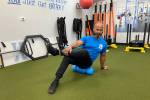Living with joint pain
It's not like cancer. Everyone knows if you have cancer, you are likely in a great deal of pain or going through excruciating chemotherapy.
Chronic pain isn't like that. Yet, it can cause such a high level of discomfort. That's why Dr. Robert Jamison calls chronic pain the invisible disability.
"People don't understand chronic pain," said Jamison, an associate professor at Harvard Medical School who specializes in chronic pain treatment. "It's not like cancer or diabetes — everyone has heard of that. But if you tell someone you have chronic back pain, people just don't understand that."
With the proper treatment and wherewithal, you can fight off those pesky chronic joint pains and decrease the chance it turns into a form of arthritis. Knowing what leads to chronic joint pain can even help you avoid the invisible disability.
It starts with maybe a crack in the ankle. Pain when you bend that right wrist. Occasional swelling in the knee.
Most people have similar aches and pains that they simply chalk up to getting older. But these little nuisances aren't just age knocking at your door — they're actually joint pain.
One of the most important aspects of dealing with these chronic pains is knowing the severity. If a pain lasts for more than three days, you should get it checked out at the doctor. If the doctor says you have a chronic pain issue, you have to realize you're fighting an uphill battle.
Jamison said dealing with chronic pain has to be less about fixing it and more about living with it.
"The fixes are very limited and few and far between. It's more a quality of life issue. You have to manage the condition and how it interferes with all aspects of your life," he said. "But people don't want to hear that. They go to the doctor for two reasons — to find out what they have and what can be done. To tell someone they have a very real condition and it is not easily fixed — that is something they don't want to hear."
Knowing what causes chronic pain in the joints is a good first step. Avoiding joint pain altogether is the only sure way to fix it.
Not all physical activity-related injuries translate to joint pain. And not all physical activities carry the same risk for joint pain. Knowing what type of activities can lead to joint pain and the symptoms of it, though, can help keep those nagging cracks, pops and swellings at bay.
The higher intensity the sport, the more likely one of the aforementioned injuries will occur. But just because a tear, break or sprain occurs doesn't mean it will lead to long-term joint pain.
If you give an injury proper time to heal, your chances of developing joint pain decrease drastically.
Jamison said this can be a tough time. He said the rule of thumb is that if you always end up hurting in bed the day after you do a certain sport or activity, then maybe that is something you'll have to give up.
"If you've been doing a sport that you've enjoyed all your life but it consistently causes pain for you, you should consult with a physical therapist to find out if there are some body mechanics that would allow for you to do it differently," said Jamison, also a member of the American Pain Society. "Sadly, there are things you enjoy that you'll have to either give up and you'll have to be creative to take on other things that aren't as aggravating."
The repetitive nature of sports — or even a physically demanding job — increases the likelihood for injury. These are commonly referred to as overuse injuries. For example, a basketball player or football player is likely to have ankle and knee problems because of the constant shifting and bursts of speed the knee must endure. A pitcher in baseball will likely face elbow or shoulder problems, even at a low level.
Construction workers and package delivery workers and those on assembly lines face an increased risk of joint pain. In fact, any line of work that requires demanding and repetitive physical activity will likely land you joint problems, as well as increase your arthritis risk.
Jamison said jobs such as construction work, nursing or an occupation that requires heavy lifting can add to the likelihood of chronic pain.
While you can stay away from certain activities or occupations, there's no denying chronic pain. It can still develop through common everyday activities or it can be hereditary.
Once you've been diagnosed with chronic joint pain, you have to learn how to deal with it.
That's the hard part.
There are steps you can take to lessen the burden. In addition to avoiding overuse injuries, you can take steps in your nutrition plan to decrease or avoid joint pain. There are supplements made specifically for the joints to aid in relief, flexibility and mobility.
Whatever the case, pretending the pain doesn't exist is the worst mode of treatment.
Shrugging off lasting pain from an injury is a common approach. It's also a dangerous one. That's because most people attribute joint pain to the normal aging process. However, that doesn't mean it's a de facto part of aging. Joint pain means something is wrong — whether it's an injury, torn tendon or early sign of arthritis. Just because so many people have aches and pains in their joints doesn't mean it's just aging, experts say.
A recent study from the Stanford Hospital and Clinic at Stanford University shows how misguided people are in the area of joint pain. A survey showed that about 20 percent of adults had some type of chronic or joint pain that affected them on a regular basis. However, not even 50 percent knew why they were in pain; they just thought it was part of the aging process. Strikingly, about 85 percent were using basic over-the-counter pills to cope with their pain. Tylenol, aspirin and ibuprofen are all commonly used drugs to combat joint pain.
Treating joint pain doesn't have to be a difficult ordeal. If cheap and easy are your preferred methods of treatment, you'll be happy to hear that's the best way to treat common joint pains. It's key to both exercise and resting the joint. Too much rest will make the joint stiff and more likely to reinjure. Too much exercise won't allow the joint time to heal. With the proper exercise/rest period in mind, massaging the joint, taking warm baths and stretching are all beneficial. Combining that regimen with proper dosage of anti-inflammatory medications is the best route for basic joint pain that is not arthritis.
Having no regimen at all won't help.
Jamison said it's very common for people to become isolated and depressed because of common pain. Many people think they need to stay in their bed or on the couch because of the great deal of pain they're in.
But they couldn't be more wrong, he said.
The main rule to follow is to be more active than inactive, Jamison said.
"You hear advice from everyone saying things you should and shouldn't do. This lends itself to getting very depressed and anxious," Jamison said. "If you have limited activity, you lose that ability to be active. This can make the pain worse. It's a really vicious cycle."























